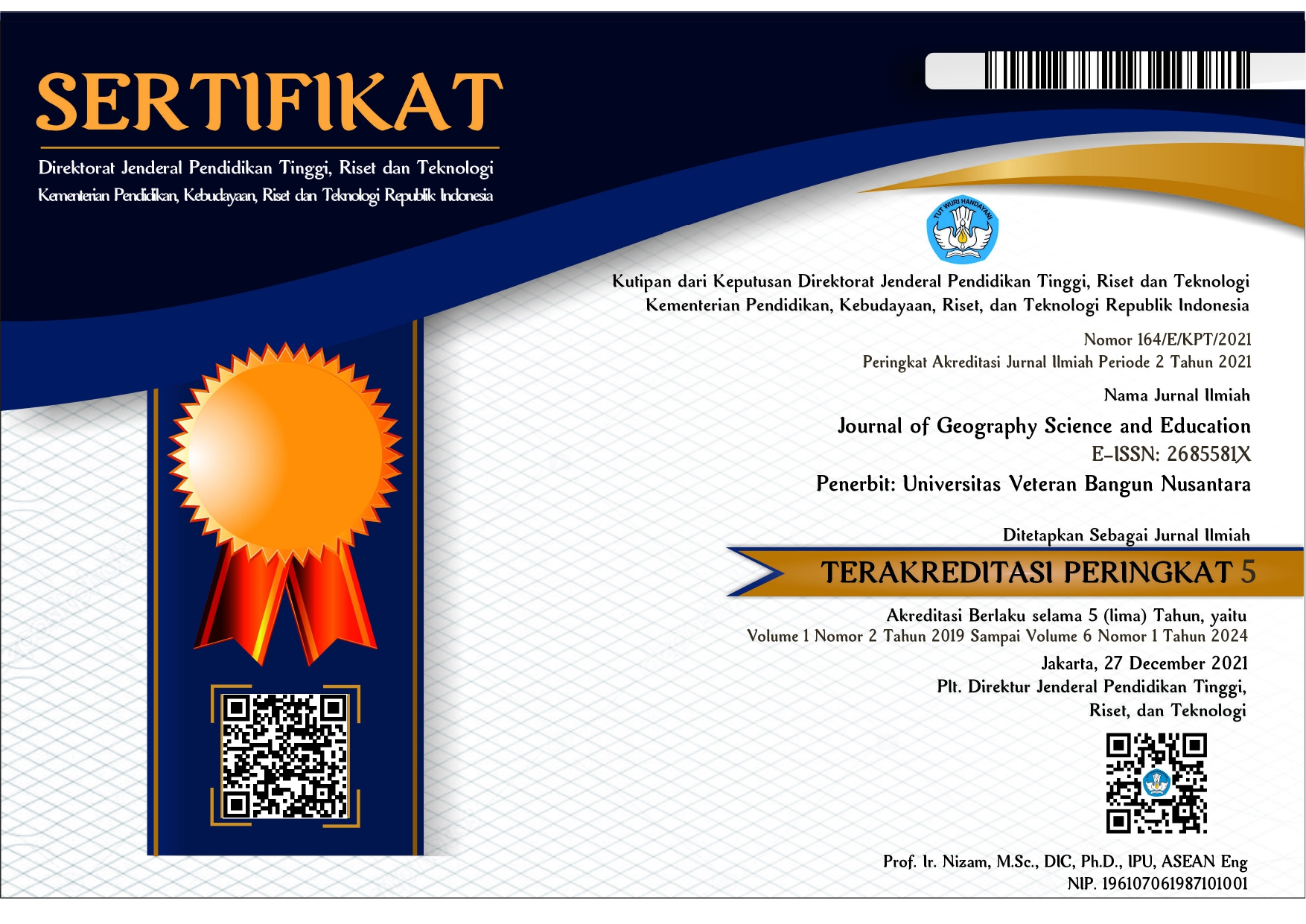THE EFFECTIVENESS OF OUTDOOR STUDY METHODS IN DEVELOPING STUDENTS' SPATIAL INTELLIGENCE IN GEOGRAPHIC LEARNING
DOI:
https://doi.org/10.32585/jgse.v4i2.2633Keywords:
Effectiveness, Outdoor Study Method, Spatial IntelligenceAbstract
The purpose of this study was to determine the effectiveness of using outdoor study in developing spatial intelligence at SMA Angkasa Husein Bandung. This research uses the expose facto, with a quantitative approach. Collecting data using a questionnaire with analytical techniques using linear regression test and correlation coefficient test. The variables in this study are the effectiveness of the outdoor study as the independent variable and spatial intelligence as the dependent variable. The sample in this study was 90 students. The results aims that the effectiveness of the outdoor study correlates with spatial intelligence with an R count of 0.824, meaning that value of the effectiveness of the outdoor study students' spatial intelligence has a very significant effect of 82.4% which shows that the outdoor study method is effective in developing spatial intelligence. The coefficient of determination Rsquare (R2)is 0.515 or 51.5%. This shows that the effectiveness of the outdoor study contributes to the spatial intelligence of students by 51.5%, the remaining 48.5% is influenced by other factors not mentioned in this study. In conclusion, the effectiveness of the outdoor study can develop students' spatial intelligence effectively in this study.
Downloads
References
Aris M., Enok Maryani., Dede Rohmat., Mamat Ruhimat. (2019). Fieldstudy Dalam Geografi. Uwais Inspirasi Indonesia.
Arinta, Dicky. 2015. Implementasi Pembelajaran Kuliah Kerja Lapangan dalam Meningkatkan Minat Belajar Mahasiswa. Program Studi Pendidikan Geografi UM.
Bungkaes H.R, J. H. Posumah, Burhanuddin Kiyai. (2013). Hubungan Efektifitas Pengelolaan Program Raskin dengan Peningkatan Kesejahteraan Masyarakat di Desa Mamahan Kecamatan Gemeh Kabupaten Kepulauan Talaud. Acta Diurna, vol. - (-) : 1-23
Cara M. Djonko-Moore And Nicole M. Joseph.2016. Out Of The Classroom And Into The City: The Use Of Field Trips As An Experiential Learning Tool In Teacher Education. DOI: 10.1177/2158244016649648 sgo.sagepub.com.
Clausen-May and Smith, Pauline. (1998). Spatial Ability: A Handbook for Teachers. Berkshire: National Foundation for Educational Research.
Creswell, John.W. 2009. Research Design: Qualitative, Quantitaive, and Mix Methods Approaches.Sage Publication, Nebrasca.
Gay, LR, Geoffrey E. Mills and Peter Airasian. 2009. Educational Research, Competencies for Analysis and Application. New Jersey: Pearson Education, Inc.
Ghasemi, Asghar dan Zahediasl, Saleh. (2012). Normality Test for Statistical Analysis: A Guide for Non-Statisticians. International Journal of Endocrinology Metabolism, 10(2), hlm. 486-489. DOI: 10.5812/ijem.3505.
Harini dkk. 2012. Pengaruh Pembelajaran Tugas Kelompok Berdasarkan Survei Lapangan (Outdoor Study) terhadap Kemampuan Menulis Karya Ilmiah dan Hasil Belajar Peserta didik. Jurnal Penelitian Pendidikan Lemlit-UM 22 (1): 12—21
Husamah. 2013. Pembelajaran Luar Kelas Outdoor Learning. Jakarta: Prestasi.
Hope, Max.2009. The Importance Of Direct Experience: A Philosophical Defence Of Fieldwork In Human Geography. Journal of Geography in Higher Education, Vol. 33, No. 2, 169–182, May 2009.
Irawan. 2005. Pendidikan Nilai Lokal Sebagai Upaya Membentuk Generasi Muda Yang Bermoral. Jurnal Pendidikan Ilmu Sosial (JPIS) Nomor 23, Halaman 42. Bandung: Media Komunikasi Antar FPIPS-UPI, FKIP Universitas/ STKIP Se-Indonesia.
Kifer, E. dalam Anglin, G. (1995) Instructional Technology, Past, Present, Future, 2nd Edition, Englewood: Colorado Libraries Unlimited Inc.
Liben, L. S. (2002). Spatial development in children: Where are we now? In U. Goswami (ed.), Blackwell handbook of childhood cognitive development. Oxford, UK, Blackwell Publishers, pp. 326-348.
Lobben, A. K. (2007). Navigational Map Reading: Predicting Performance and Identifying Relative Influence of Map-Related Abilities. In Annals of the Association of American Geographers. 97(1), 64-85.
Muhammad Falik Arsa, Dede Sugandi, Lili Somantri. 2018. The Influence Of GIS Learning Material On Spatial Thinking Of Students In SMA/MAN Banda Aceh. Proceedings : ICEE Global Perspective on 21st Elementary Education Volume 2 Nomor 1, ISBN 978-623-7776-07-9
Purwanto, M.N. (2001). Prinsip-Prinsip Dan Teknik Evaluasi Pembelajaran. Bandung: Remaja Rosdakarya.
Putra,Exsa, Bima Aji Tantular, Mamat Ruhimat. 2020. The Effect of SimCity as Instructional Media in Geography Learning on Learners’ Spatial Intelligence. ICEDS 2020: Proceedings of the 2020 International Conference on Education Development and Studies. DOI: https://dl.acm.org/doi/10.1145/3392305.3396896
Putra,Exsa. 2017. Penerapan Model Pembelajaran Inquiry Untuk Meningkatkan Kemampuan Berpikir Kritis Peserta Didik Pada Mata Pelajaran Geografi (Penelitian Tindakan Kelas di Kelas X-IPS 4 SMA Negeri 15 Kota Bandung.
http://repository.upi.edu/23883/4.haslightboxThumbnailVersion/S_GEO_1202831_Chapter1.pdf
Putra,Exsa. 2021. Efektifitas Metode Outdoor Study dalam Mengembangkan Kecerdasan Spasial Peserta Didik Kelas XII Di SMA Angkasa Lanud Husein Sastranegara Bandung. S2 thesis, Universitas Pendidikan Indonesia. http://repository.upi.edu/58872/1/T_GEO_1803617_Title.pdf
Madaus, G.F., Sriven, M.S., dan Stufflebeam. (1987). Evaluation Models Viewpoints on Educational and Human Services Evaluation. Boston: Kluwer Nijboff Publishing.
Marc Behrendt. A Review Of Research On School Field Trips And Their Value In Education. DOI: 10.12973/ijese.2014.213a
Tshepang, Rose. Tlatane. Peran fieldtrip dalam meningkatkan Pendidikan warisan dunia. Universitas Pendidikan Hong Kong.
Downloads
Published
How to Cite
Issue
Section
License
Authors who publish with the Journal of Geography Science and Education agree to the following terms:
- Authors retain copyright and grant the journal the right of first publication with the work simultaneously licensed under a Creative Commons Attribution License (CC BY-SA 4.0) that allows others to share the work with an acknowledgment of the work's authorship and initial publication in this journal.
- Authors are able to enter into separate, additional contractual arrangements for the non-exclusive distribution of the journal's published version of the work (e.g., post it to an institutional repository or publish it in a book), with an acknowledgment of its initial publication in this journal.
- Authors are permitted and encouraged to post their work online (e.g., in institutional repositories or on their website) prior to and during the submission process, as it can lead to productive exchanges, as well as earlier and greater citation of published work.










